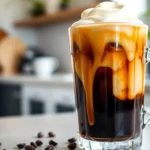We’ve discovered the perfect fusion of tropical paradise and creamy comfort in every sip of Okinawa milk tea. This mesmerizing purple-hued beverage originated from the beautiful Japanese island of Okinawa and has taken the industry by storm with its unique sweet potato flavor and stunning color.
What makes this drink absolutely irresistible is its signature ingredient – purple sweet potato powder – which creates that Instagram-worthy violet shade we all love. The earthy sweetness of Okinawan purple potatoes blends beautifully with rich black tea and creamy milk, creating a flavor profile that’s both exotic and comforting.
We’re thrilled to share this simple yet impressive recipe that’ll transport your taste buds straight to the pristine beaches of Okinawa. Whether you’re looking to impress guests or simply treat yourself to something special, this vibrant milk tea delivers both visual appeal and unforgettable taste in every perfectly balanced cup.
What Is Okinawa Milk Tea
Okinawa milk tea represents a distinctive Japanese beverage that originated from the subtropical island of Okinawa. This vibrant purple drink combines traditional black tea with the island’s famous purple sweet potatoes to create a unique flavor experience that sets it apart from conventional milk teas.
The beverage features purple sweet potato powder as its signature ingredient which provides both the stunning violet color and the naturally sweet earthy flavor profile. We find that this powder blends seamlessly with robust black tea to create a base that’s both visually striking and deliciously complex.
Traditional preparation involves steeping strong black tea and incorporating purple sweet potato powder along with milk or cream to achieve the characteristic creamy texture. The drink often includes brown sugar or other sweeteners to balance the natural flavors and enhance the overall taste experience.
Okinawa milk tea differs significantly from other popular milk tea varieties like Thai tea or Hong Kong milk tea due to its unique purple sweet potato component. The natural sweetness from the sweet potato powder creates a more nuanced flavor compared to artificially flavored alternatives commonly found in bubble tea shops.
The beverage has gained international popularity through social media platforms where its photogenic purple hue makes it highly shareable. We’ve observed that many cafes worldwide now offer their own interpretations of this Okinawan specialty often served both hot and cold depending on seasonal preferences.
Modern variations include toppings such as tapioca pearls boba or cheese foam to cater to contemporary milk tea trends. The drink maintains its authentic roots while adapting to global tastes making it accessible to a wider audience seeking both novelty and tradition in their beverage choices.
Ingredients

We need exact ingredients to create this authentic Okinawan beverage that balances rich caramelized sweetness with robust tea flavors. Our recipe focuses on traditional kokuto sugar which gives Okinawa milk tea its distinctive taste profile.
For the Brown Sugar Syrup
- 3 ounces kokuto sugar (Okinawan brown sugar)
- 2 cups water for dissolving the sugar
For the Tea Base
- 3 tablespoons loose-leaf Assam black tea
- 6 cups water
- 1½ cups whole milk (recommended for best flavor)
For Assembly
- 4 tablespoons tapioca pearls
- 3 cups water for boiling pearls
- Prepared brown sugar syrup
- Prepared tea base
- Ice cubes (optional for cold serving)
Equipment Needed
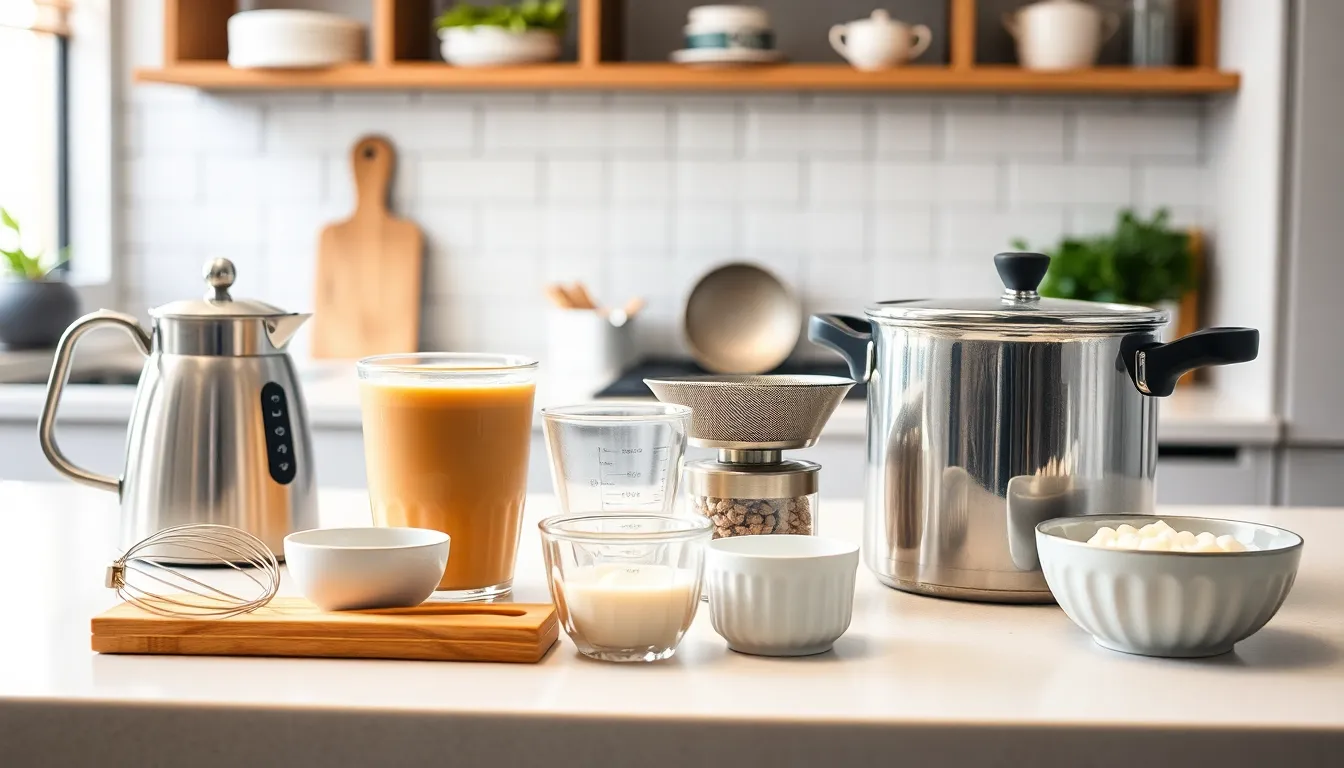
Making authentic Okinawa milk tea requires exact tools to achieve the perfect flavor and texture we’re aiming for. We’ve compiled a comprehensive list of essential equipment that will help you create this distinctive Japanese beverage with confidence.
Essential Brewing Equipment:
- Tea Kettle – For heating water to the optimal brewing temperature
- Whisk – To properly dissolve kokuto sugar and create smooth syrup
- Tea Strainer or Infuser – For steeping loose-leaf Assam tea effectively
- Measuring Cups and Spoons – To ensure accurate ingredient ratios
Serving and Preparation Tools:
- Tea Cups or Coffee Mugs – For serving the finished beverage
- Soup Pot – Necessary for boiling tapioca pearls if using boba
- Long-handled Spoon – For stirring and mixing ingredients thoroughly
- Bubble Tea Straws (optional) – Wide straws designed for tapioca pearls
Specialized Items for Best Results:
- Fine-mesh Strainer – To remove any tea particles for smooth texture
- Small Saucepan – For creating the kokuto sugar syrup base
- Glass or Stainless Steel Mixing Bowl – For combining ingredients without flavor transfer
Most home kitchens already contain the basic equipment needed for this recipe. The soup pot becomes essential when preparing tapioca pearls from scratch, while bubble tea straws enhance the authentic experience when serving with boba. We recommend having all equipment ready before beginning preparation to ensure a smooth brewing process.
Instructions
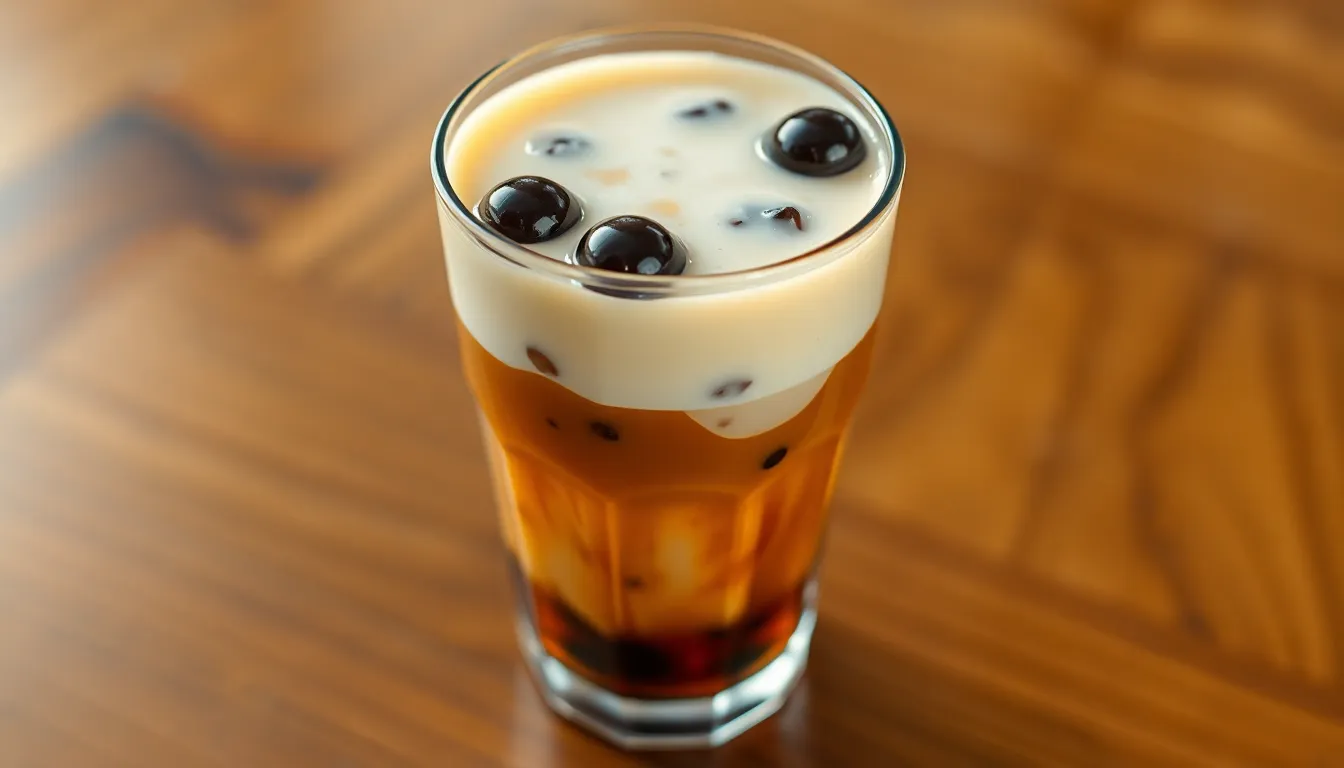
We’ll guide you through the three essential steps to create authentic Okinawa milk tea with its signature rich flavor and beautiful color. Each component requires careful attention to achieve the perfect balance of sweetness and strength.
Making the Brown Sugar Syrup
We begin by creating the distinctive brown sugar syrup that gives Okinawa milk tea its characteristic sweetness. Combine ½ cup (100g) of Okinawan brown sugar (kokuto) with ¼ cup (60ml) of water in a medium saucepan. Place the mixture over medium-high heat and bring it to a rolling boil while stirring occasionally to dissolve the sugar completely.
Once boiling, we reduce the heat to medium and continue cooking the syrup. The mixture will bubble vigorously as the water evaporates and the sugar concentrates. We cook until the syrup reaches a thick, sticky consistency that coats the back of a spoon. This process typically takes 5-7 minutes but watch carefully to prevent burning. The finished syrup should have a deep amber color and rich caramel aroma.
Preparing the Tea Base
Strong black tea forms the foundation of our Okinawa milk tea, so we select loose-leaf Assam tea for its robust flavor. Bring 2 cups (450ml) of water to a full boil in our tea kettle. Add 3 teaspoons (10g) of loose-leaf Assam black tea to the boiling water and remove from heat immediately.
We steep the tea leaves for exactly 3-5 minutes to extract optimal flavor without introducing bitterness. Longer steeping times will create an overly bitter tea that overwhelms the delicate brown sugar notes. Strain the tea through our fine-mesh strainer to remove all leaf particles and set aside to cool slightly before assembly.
Assembling the Okinawa Milk Tea
Our final step brings together all components to create the signature layered appearance and balanced flavor. Add the prepared brown sugar syrup to the bottom of our serving glasses, followed by ¾ cup (100g) of cooked tapioca pearls if using. The syrup will coat the pearls and create beautiful amber streaks throughout the drink.
Pour the warm tea base slowly over the back of a spoon to create distinct layers in the glass. Add ½ cup (120ml) of whole milk in the same gentle manner to maintain separation between components. We stir the mixture gently with a long spoon to combine flavors while preserving some of the visual layering effect. Taste and adjust sweetness by adding more brown sugar syrup as desired before serving immediately.
Directions for Hot Version
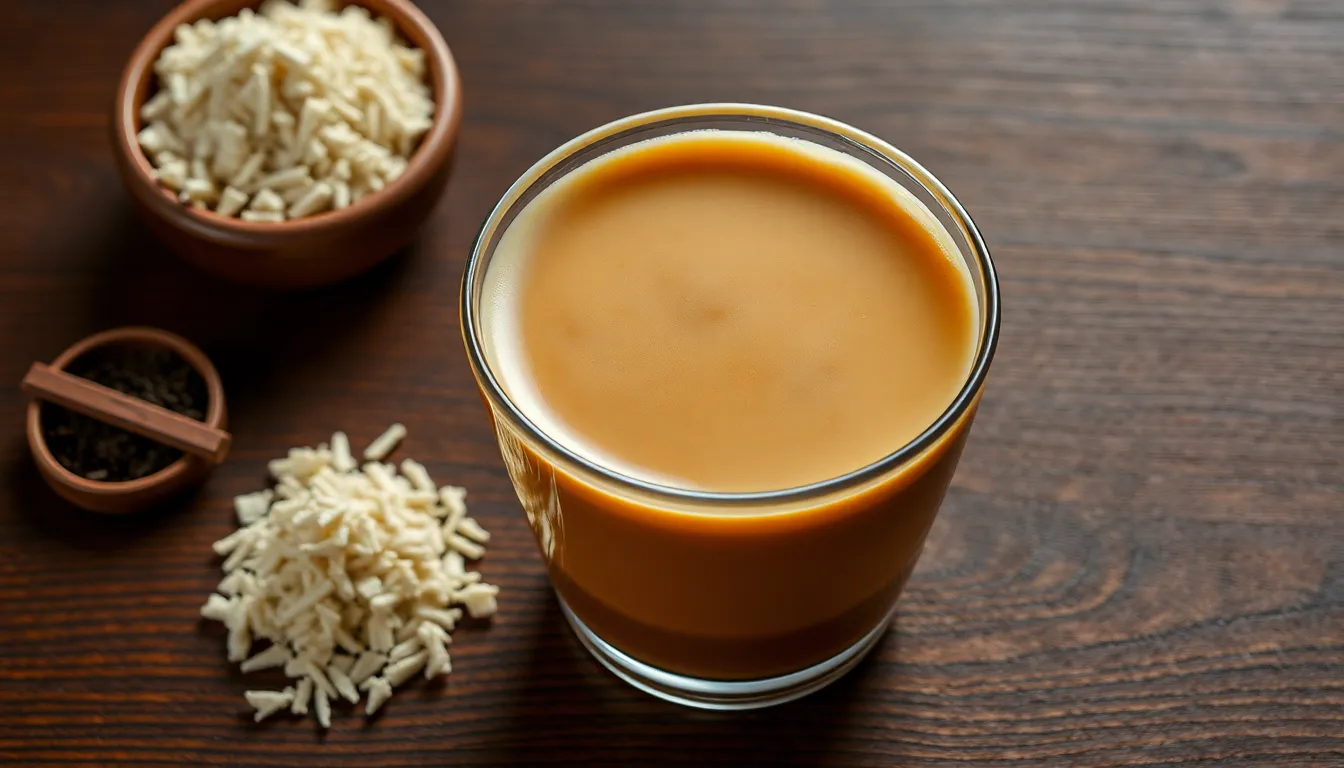
We begin by creating the essential kokuto sugar syrup that gives Okinawa milk tea its signature caramelized sweetness. Combine ½ cup of kokuto sugar with ¼ cup of water in a medium saucepan. Place the mixture over medium-high heat and bring to a vigorous boil. Once boiling, reduce the heat to medium and continue cooking until the syrup thickens to a honey-like consistency, which typically takes 8-10 minutes.
Our next step involves preparing the tapioca pearls for optimal flavor absorption. Cook the tapioca pearls according to their package instructions, usually boiling them for 15-20 minutes until they achieve a chewy texture. Drain the pearls immediately and transfer them to the warm sugar syrup. Allow them to soak on low heat for 3-5 minutes, ensuring each pearl becomes thoroughly coated with the caramelized syrup.
We now focus on brewing the perfect tea base that will anchor our Okinawa milk tea. Bring 2 cups of water to a rolling boil in our tea kettle. Add 3 teaspoons of loose-leaf Assam black tea to the boiling water and steep for exactly 4 minutes to extract maximum flavor without introducing bitterness. Strain the tea immediately to prevent over-extraction.
The final assembly requires careful attention to temperature and layering. Pour the hot tea into a large serving cup, leaving room for milk and pearls. Add 2-3 tablespoons of the kokuto sugar syrup to the tea and stir gently to combine. Pour ½ cup of hot milk into the mixture, creating a rich and creamy base.
We complete our hot Okinawa milk tea by spooning the sugar-coated tapioca pearls into the bottom of the cup. The pearls should be warm and glossy from their syrup bath. Serve immediately while all components maintain their optimal hot temperature for the most authentic experience.
Directions for Iced Version
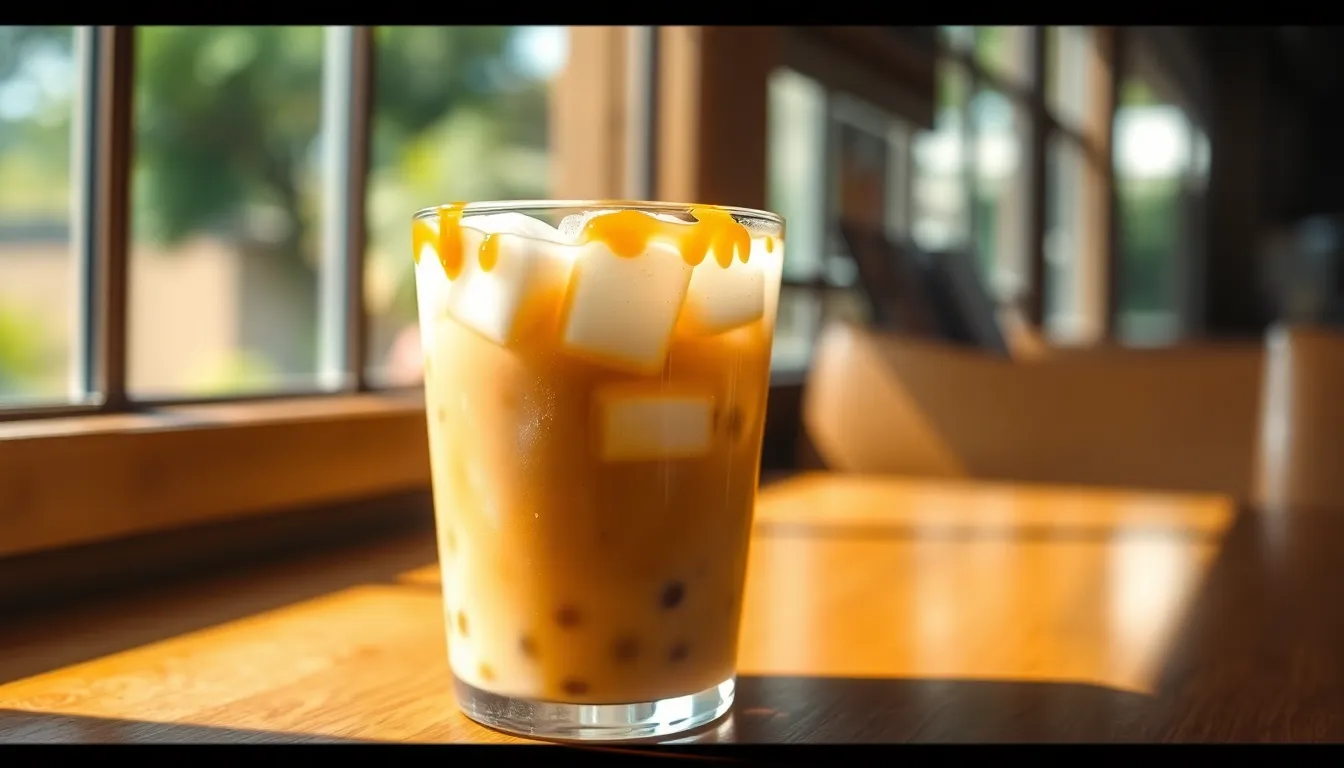
We’ll walk you through creating the perfect iced Okinawa milk tea by following these essential steps that transform the traditional hot preparation into a refreshing cold beverage.
Step 1: Create the Kokuto Sugar Syrup
We start by combining the kokuto sugar with water in a small saucepan over low heat. Simmer this mixture gently until it becomes thick and sticky, which typically takes 8-10 minutes. The syrup should coat the back of a spoon when ready. We then set this aside to cool slightly while maintaining its pourable consistency.
Step 2: Prepare the Tapioca Pearls
We bring a pot of water to a rolling boil and add the tapioca pearls. Cook them for 4-6 minutes until they become soft and chewy throughout. Once cooked, we drain the pearls immediately and mix them with the warm kokuto syrup while both components are still hot. This allows the pearls to absorb the rich caramel flavor.
Step 3: Brew the Black Tea Base
We steep the loose-leaf Assam black tea in freshly boiled water for 3-5 minutes to achieve the robust flavor needed for this drink. Steeping longer than 5 minutes will create unwanted bitterness. After the steeping time, we strain out all tea leaves and allow the tea to cool to room temperature.
Step 4: Combine and Chill
We add the whole milk directly to our cooled tea base and stir thoroughly to create a smooth mixture. Next, we incorporate the kokuto syrup along with the sugar-coated tapioca pearls, mixing everything together until well combined.
Step 5: Serve Over Ice
We fill tall glasses with plenty of ice cubes and pour our Okinawa milk tea mixture over the ice. The drink should be served immediately with wide bubble tea straws to accommodate the tapioca pearls. This creates the perfect refreshing experience with each sip delivering the signature caramelized sweetness and chewy texture that makes this beverage so distinctive.
Make-Ahead Tips
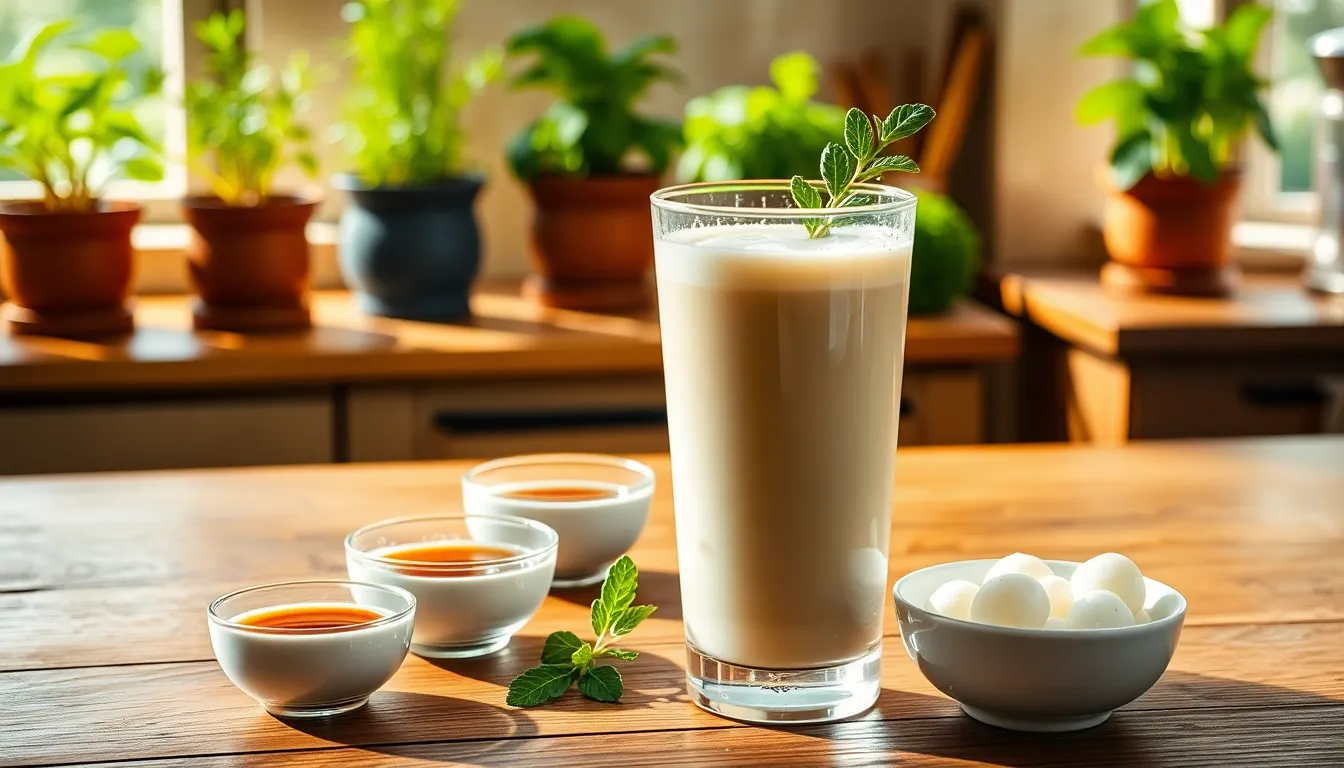
We can streamline our Okinawa milk tea preparation by making several components ahead of time. This approach allows us to enjoy fresh tea without the full preparation time when we’re ready to serve.
Tea Base Preparation
Brewing our black tea in advance offers important convenience benefits. We recommend preparing a large batch of Assam tea and storing it in the refrigerator for up to three days. The chilled tea actually develops a smoother flavor profile as it rests. When we’re ready to serve we simply need to reheat the portion we need or use it cold for iced versions.
Kokuto Sugar Syrup Storage
Our kokuto sugar syrup stores exceptionally well when prepared in advance. We can make a large batch and keep it in an airtight container in the refrigerator for up to three days. The syrup will thicken as it cools but we can easily restore its pourable consistency by gently reheating it in a small saucepan or warming it briefly in the microwave.
| Component | Storage Method | Shelf Life | Reheating Instructions |
|---|---|---|---|
| Brewed Tea | Refrigerated in sealed container | 3 days | Reheat in saucepan or serve cold |
| Kokuto Syrup | Airtight container in refrigerator | 3 days | Gentle heat until liquefied |
| Cooked Boba | In syrup for 2-4 hours | Same day | Brief warm water bath |
Tapioca Pearl Management
Tapioca pearls present the biggest challenge for make ahead preparation since they harden quickly after cooking. We suggest par cooking the pearls until they’re about 80% done then storing them in a small amount of kokuto syrup. This method keeps them pliable for 2 to 4 hours maximum. We can revive slightly firm pearls by briefly warming them in hot water before serving.
Assembly Strategy
We achieve the best results by storing each component separately until serving time. The tea base and kokuto syrup maintain their quality when refrigerated while the milk should be added fresh during assembly. This separation prevents the milk from separating or developing off flavors during storage.
Serving Preparation
When we’re ready to serve we can quickly assemble individual drinks by adjusting the kokuto syrup amount to each person’s sweetness preference. Having pre portioned syrup in small containers makes this process even more efficient during busy entertaining moments.
Serving Suggestions
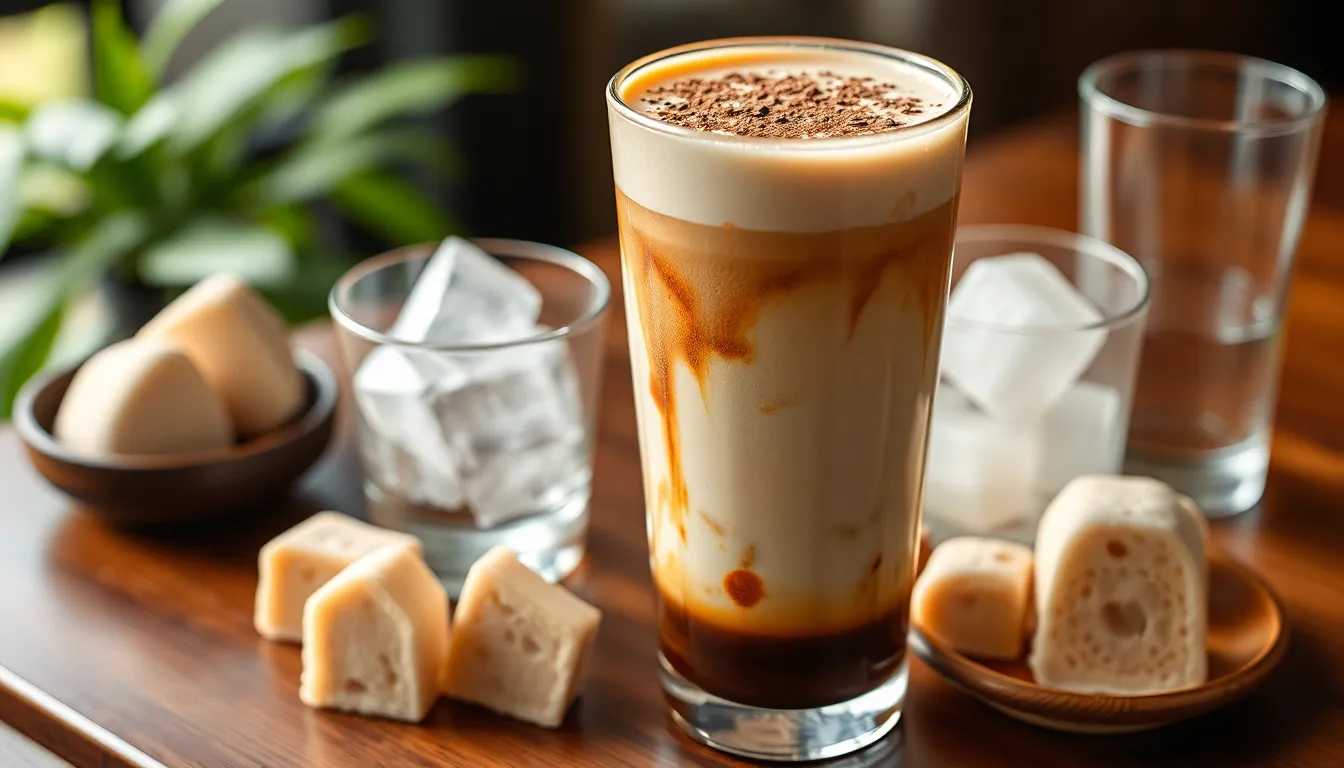
We recommend serving Okinawa milk tea in clear glasses to showcase its beautiful layered appearance. Traditional bubble tea glasses work perfectly for this purpose since they highlight the rich brown sugar syrup at the bottom and the creamy tea mixture above.
For hot versions, we suggest using ceramic mugs or heat-resistant glass cups to maintain the temperature while protecting your hands. Serve immediately after preparation to ensure all components remain at their optimal warmth. The kokuto sugar syrup creates a delightful caramelized flavor that pairs beautifully with the robust black tea base.
Cold preparations benefit from tall glasses filled with ice cubes for maximum refreshment. We always add the ice after pouring the cooled tea mixture to prevent dilution of the carefully balanced flavors. The chilled version allows the earthy sweetness of the kokuto sugar to shine through more prominently.
Wide bubble tea straws are essential when serving with tapioca pearls. These specialty straws accommodate the chewy pearls while allowing guests to enjoy the full texture experience. We stock both reusable glass straws and biodegradable paper alternatives for environmentally conscious serving.
Presentation enhances the overall experience significantly. We garnish each glass with a light dusting of cocoa powder or a cinnamon stick for visual appeal. Small spoons alongside the drinks help guests mix the layered components before sipping.
Consider serving Okinawa milk tea alongside traditional Japanese sweets like mochi or dorayaki. The caramelized notes in the kokuto sugar complement these treats perfectly. Light pastries and butter cookies also pair wonderfully with the rich tea base.
For special occasions, we create a tea flight featuring different kokuto sugar concentrations. This allows guests to experience how varying syrup amounts affect the overall flavor profile. Small tasting glasses work best for this interactive serving style.
Temperature control matters greatly for optimal enjoyment. Hot versions should reach approximately 160°F before serving, while cold preparations taste best when chilled to 40°F. We use thermometers to ensure consistent quality across all servings.
Storage Instructions
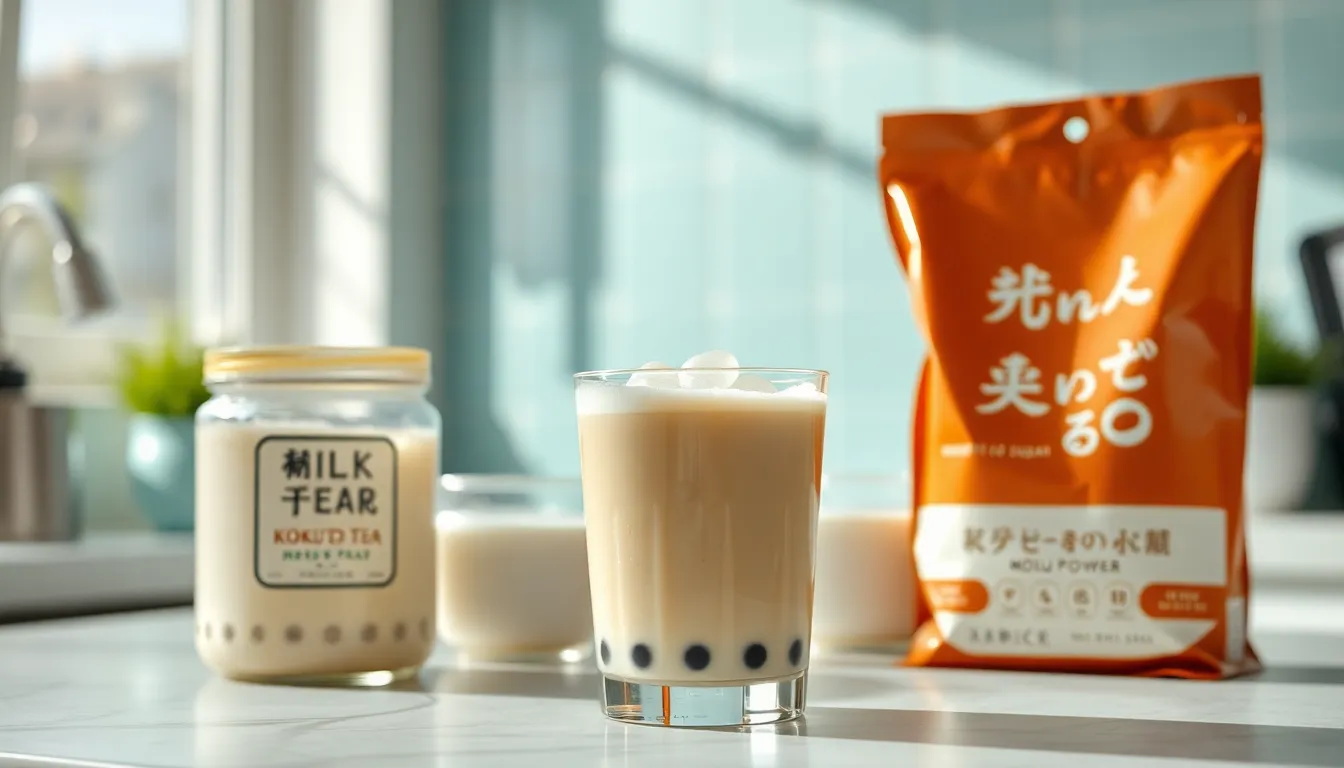
Proper storage ensures our Okinawa milk tea maintains its distinctive flavor and quality over time. We need to follow different guidelines depending on whether we’re storing the powdered ingredients or the prepared beverage.
Storing Powdered Ingredients
Our Okinawa milk tea powder requires careful storage to preserve its rich caramel-like sweetness. We should keep the powder in a cool, dry place away from excessive heat, moisture, and direct light. After opening any package, we must seal the bag tightly to maintain freshness and prevent the powder from absorbing unwanted odors or moisture from the air.
The kokuto sugar we use for authentic Okinawa milk tea follows similar storage principles. We store it in an airtight container in a cool, dry location where temperature fluctuations won’t affect its texture or flavor profile.
Storing Prepared Tea
Our freshly prepared Okinawa milk tea has a much shorter storage window than the dry ingredients. We should serve the completed beverage immediately after preparation to prevent the tapioca pearls from becoming soggy and losing their signature chewy texture.
When we must store prepared Okinawa milk tea, we need to consume it within 1-2 hours for optimal quality. The milk components can separate over time, and the tea’s temperature will affect the overall drinking experience.
Storage Duration Guidelines
| Component | Storage Method | Duration |
|---|---|---|
| Kokuto sugar powder | Airtight container, cool dry place | 6-12 months |
| Black tea leaves | Sealed container, room temperature | 2-3 years |
| Prepared milk tea | Refrigerated, covered | 1-2 hours |
| Cooked tapioca pearls | Room temperature in syrup | 4-6 hours |
We avoid storing prepared Okinawa milk tea overnight as the flavor compounds break down and the texture becomes unpalatable. Our tapioca pearls require special attention since they harden quickly when cooled, making them difficult to enjoy if stored improperly.
Variations and Substitutions
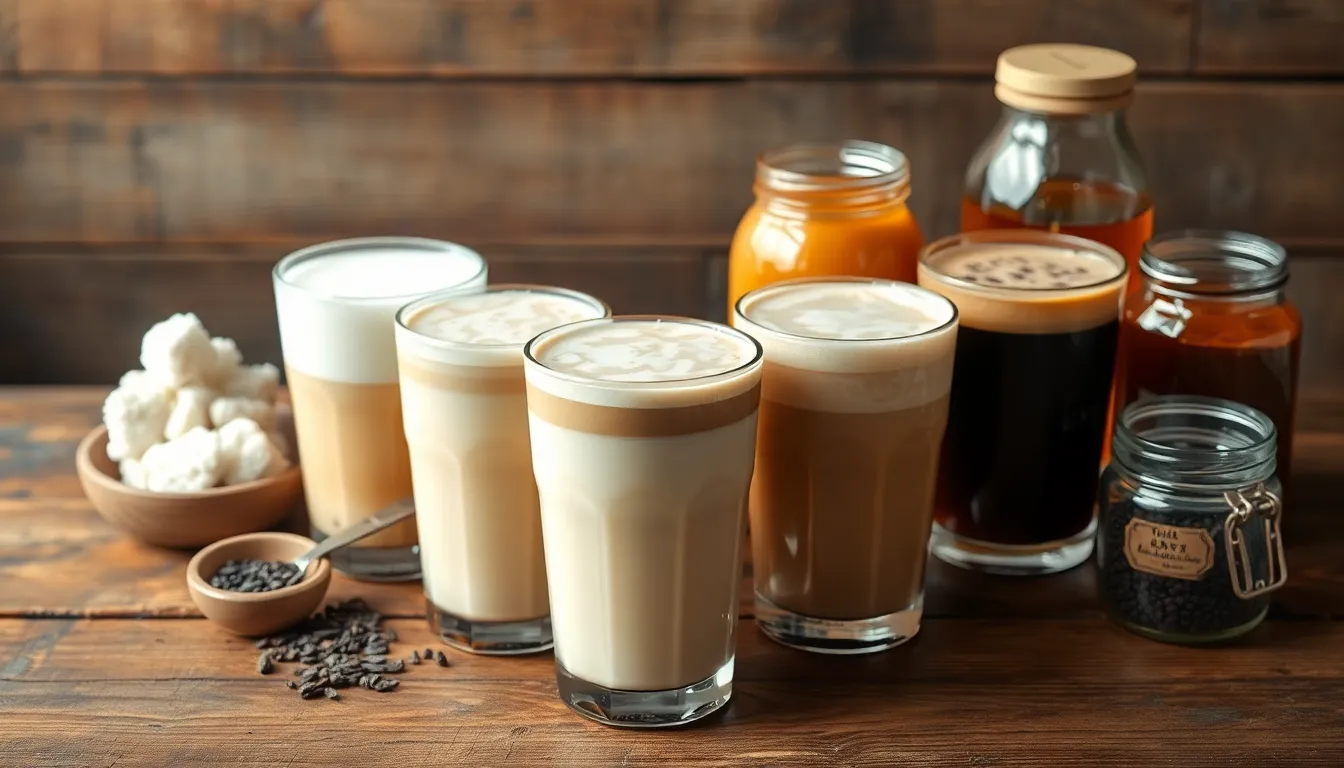
We understand that finding authentic Okinawan ingredients can be challenging, so we’ve compiled these practical alternatives to help you create delicious milk tea regardless of what’s available in your pantry. These substitutions maintain the essence of the original while accommodating different dietary preferences and ingredient availability.
Alternative Sweeteners
Traditional kokuto sugar delivers the authentic caramelized sweetness that defines Okinawa milk tea, but several alternatives work beautifully when this specialty ingredient isn’t accessible. Regular brown sugar serves as our most reliable substitute, offering similar molasses notes that complement the black tea base without overwhelming the drink’s delicate balance.
Molasses provides a deeper, more robust flavor profile that appeals to those who prefer bolder sweetness in their beverages. We recommend starting with half the amount since molasses carries more intense flavor than kokuto sugar.
Honey creates a floral sweetness that transforms the drink into a lighter, more aromatic experience. Maple syrup brings subtle vanilla undertones that pair exceptionally well with the earthy tea base, making it our favorite alternative for autumn variations.
Milk Options
Whole milk remains our preferred choice for achieving the creamy, luxurious texture that makes Okinawa milk tea so satisfying. The higher fat content creates a smooth mouthfeel that balances perfectly with the robust black tea and sweet potato flavors.
Condensed milk elevates the drink to dessert status with its concentrated sweetness and incredibly rich consistency. We suggest reducing other sweeteners when using condensed milk to prevent the drink from becoming overly sweet.
Plant based alternatives like oat milk work surprisingly well, providing natural creaminess that doesn’t compete with the tea’s flavor profile. Coconut milk adds tropical notes that complement the Okinawan origins, while almond milk creates a lighter version perfect for those watching calories.
Tea Variations
Assam black tea forms the traditional foundation with its malty strength that stands up beautifully to milk and sweeteners without losing character. This robust variety steeps quickly and delivers the bold flavor profile essential for authentic Okinawa milk tea.
Ceylon black tea offers a brighter, more citrusy alternative that creates a lighter version while maintaining the necessary strength for milk tea preparation. Earl Grey introduces bergamot notes that add sophisticated complexity, though we recommend using it sparingly to avoid overwhelming the sweet potato elements.
English Breakfast blend provides reliable consistency and familiar flavor that works well for those new to milk tea making. Darjeeling creates a more delicate version with subtle muscatel notes, perfect for afternoon serving when you prefer gentler flavors.
Troubleshooting Common Issues
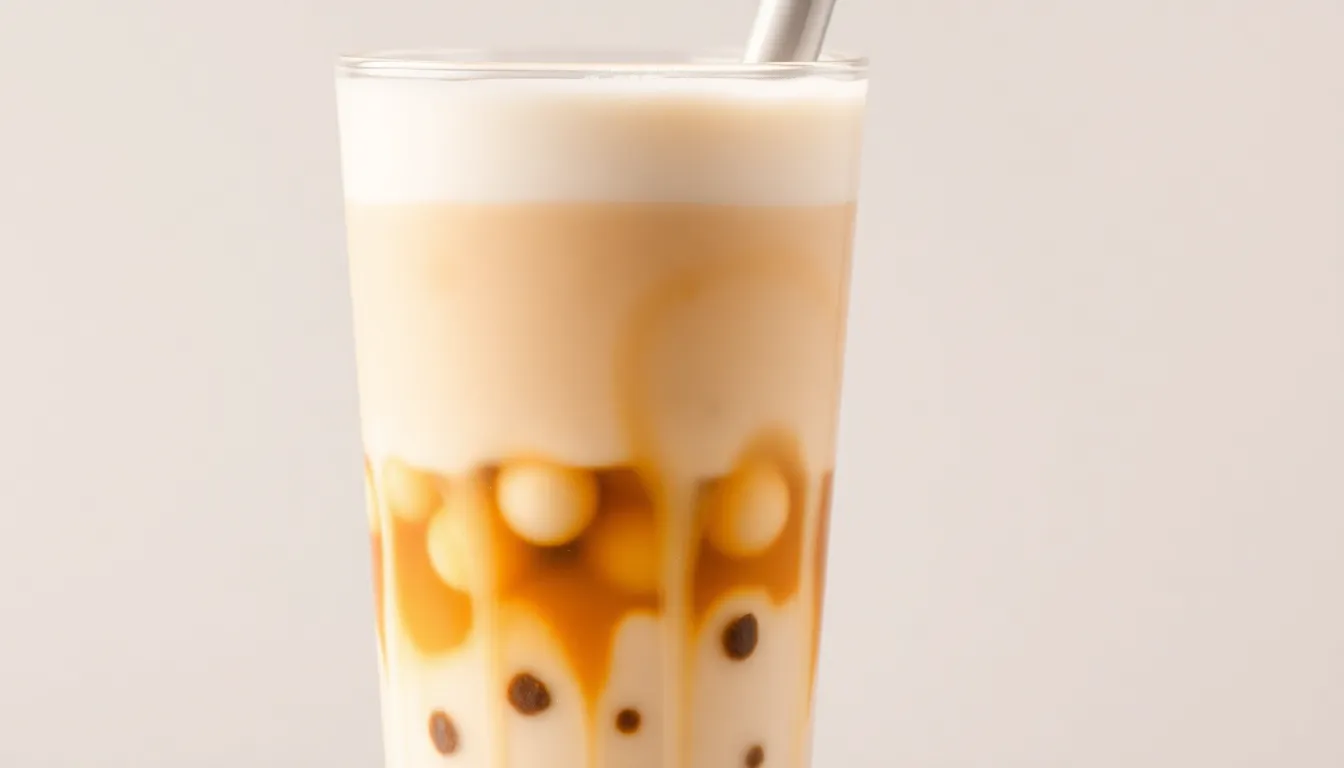
Tea Base Too Bitter
When our Assam black tea tastes overly bitter, we’ve likely steeped it too long or used water that’s too hot. The optimal steeping time for Okinawa milk tea is 3-5 minutes maximum. Water temperature should reach boiling but then cool for 30 seconds before pouring over the tea leaves. We recommend tasting the tea base before adding milk to ensure it’s not overpowering the delicate kokuto sugar flavors.
Kokuto Sugar Won’t Dissolve Properly
If our kokuto sugar forms clumps or refuses to dissolve completely, the water temperature might be insufficient. Kokuto sugar requires consistent heat and stirring to break down properly. We should bring the water to a rolling boil before adding the sugar, then reduce heat to medium while stirring continuously. Adding the sugar gradually instead of all at once prevents crystallization and ensures smooth syrup consistency.
Tapioca Pearls Become Too Hard or Mushy
Achieving the perfect chewy texture for tapioca pearls requires precise timing. Hard pearls indicate undercooking, while mushy ones signal overcooking. We cook our tapioca pearls for exactly 15-20 minutes in boiling water, then let them sit in hot water for another 15 minutes off the heat. Testing one pearl every few minutes helps us achieve that ideal bounce without mushiness.
Milk Separates in Hot Tea
Temperature shock causes milk to curdle when added to very hot tea. We prevent this by tempering the milk first – warming it gently in a separate pan or adding a small amount of hot tea to the cold milk before combining. Room temperature milk works better than cold milk straight from the refrigerator. Adding milk gradually while stirring constantly also reduces separation risk.
Drink Lacks Authentic Flavor
When our Okinawa milk tea tastes flat or generic, the kokuto sugar ratio might be insufficient. Authentic Okinawan brown sugar provides the signature caramelized sweetness that distinguishes this tea from regular milk tea. We increase the kokuto syrup gradually until we achieve that rich, molasses-like depth. Using high-quality loose-leaf Assam tea instead of tea bags also intensifies the authentic flavor profile.
Layered Effect Won’t Form
Creating distinct layers requires different densities between components. Our kokuto syrup should be thick enough to settle at the bottom, while the milk should float on top of the tea. We achieve this by ensuring the syrup is properly concentrated and the tea has cooled slightly before assembly. Pouring each layer slowly over the back of a spoon helps maintain separation.
Pearls Sink to Bottom Too Quickly
When tapioca pearls settle immediately instead of distributing throughout the drink, they’re either too heavy or the liquid is too thin. We solve this by ensuring our pearls are properly cooked but not oversaturated with syrup. Stirring the drink gently before serving redistributes the pearls, and using wide bubble tea straws makes every sip enjoyable.
Conclusion
We’ve explored everything you need to know about creating authentic Okinawa milk tea at home. From understanding the unique kokuto sugar to mastering the perfect brewing technique this distinctive beverage offers a delightful departure from ordinary milk teas.
The beauty of Okinawa milk tea lies in its versatility and forgiving nature. Whether you’re serving it hot on a chilly morning or iced during summer afternoons the rich caramelized sweetness and smooth tea base deliver consistent satisfaction.
With our detailed recipes troubleshooting tips and make-ahead strategies you’re well-equipped to impress friends and family with this Instagram-worthy drink. The time you invest in sourcing quality ingredients and perfecting your technique will reward you with an authentic taste of Okinawan culture in every sip.
Frequently Asked Questions
What is Okinawa milk tea?
Okinawa milk tea is a vibrant purple beverage from the Japanese island of Okinawa, known for its unique sweet potato flavor. It combines traditional black tea with purple sweet potato powder, creating a stunning violet color and naturally sweet, earthy taste. The drink is often sweetened with kokuto (Okinawan brown sugar) and served with milk or cream.
What makes Okinawa milk tea different from other milk teas?
Okinawa milk tea stands out due to its unique purple sweet potato ingredient, which gives it a distinctive earthy flavor and vibrant violet color. Unlike Thai tea or Hong Kong milk tea that rely on artificial flavoring, Okinawa milk tea offers a more nuanced, naturally sweet taste profile that’s both authentic and visually striking.
What ingredients do I need to make Okinawa milk tea?
The essential ingredients include kokuto (Okinawan brown sugar) for syrup, loose-leaf Assam black tea, whole milk, and purple sweet potato powder. Optional additions include tapioca pearls for texture. If kokuto isn’t available, regular brown sugar can be substituted, though it will alter the authentic flavor slightly.
Can I make Okinawa milk tea ahead of time?
Yes, you can prepare components in advance. Brew Assam tea and store it refrigerated for up to 3 days for smoother flavor. Kokuto syrup can be made ahead and stored in an airtight container for 3 days. However, assemble drinks fresh with milk to prevent separation and maintain quality.
How do I store leftover Okinawa milk tea?
Prepared Okinawa milk tea should be consumed within 1-2 hours to prevent tapioca pearls from becoming soggy and milk from separating. Store dry ingredients like sweet potato powder and kokuto sugar in airtight containers in cool, dry places. Pre-made tea base can be refrigerated for up to 3 days.
What are good substitutes for kokuto sugar?
If kokuto sugar isn’t available, you can substitute with regular brown sugar, molasses, honey, or maple syrup. Each offers a different flavor profile – molasses provides deep richness, honey adds floral notes, and maple syrup contributes subtle complexity. Regular brown sugar is the closest alternative.
Can I make Okinawa milk tea without tapioca pearls?
Absolutely! Tapioca pearls are optional and the drink is delicious without them. You can also substitute with other toppings like popping boba, jelly cubes, or simply enjoy it as a smooth milk tea. The purple sweet potato flavor remains the star regardless of toppings.
Why is my Okinawa milk tea bitter?
Bitter tea typically results from over-steeping the black tea or using water that’s too hot. Steep Assam tea for no more than 3-5 minutes and use water around 200°F (93°C). If it’s still bitter, reduce steeping time or add more milk and sweetener to balance the flavor.
How do I achieve the perfect layered look?
Pour ingredients slowly and in the correct order: kokuto syrup first, then tapioca pearls, followed by the cooled tea base, and finally milk poured gently over the back of a spoon. Use clear glasses to showcase the beautiful layers and serve immediately for the best visual effect.
Is Okinawa milk tea served hot or cold?
Okinawa milk tea can be enjoyed both hot and cold. The hot version should be served immediately while all components are warm for an authentic experience. The iced version is perfect for hot weather and allows the flavors to meld beautifully over ice, creating a refreshing treat.





